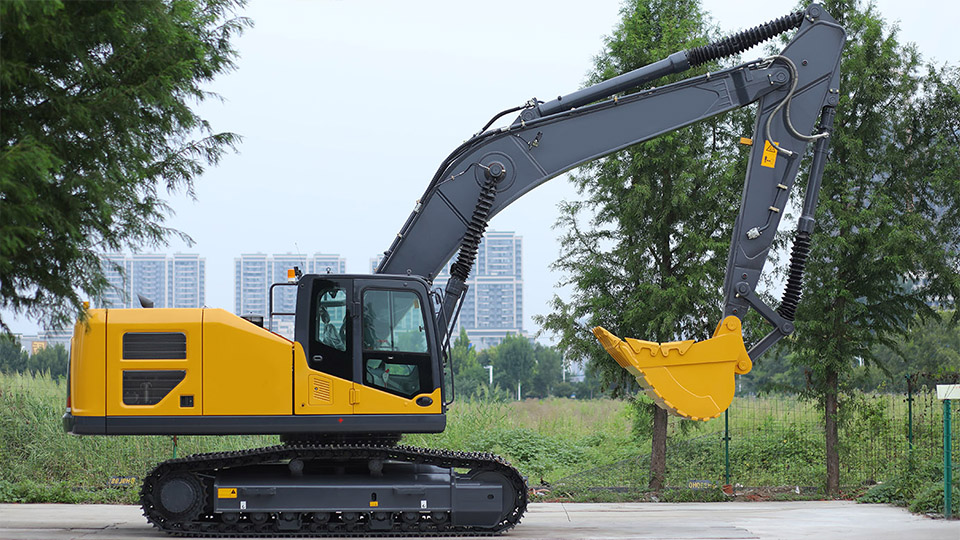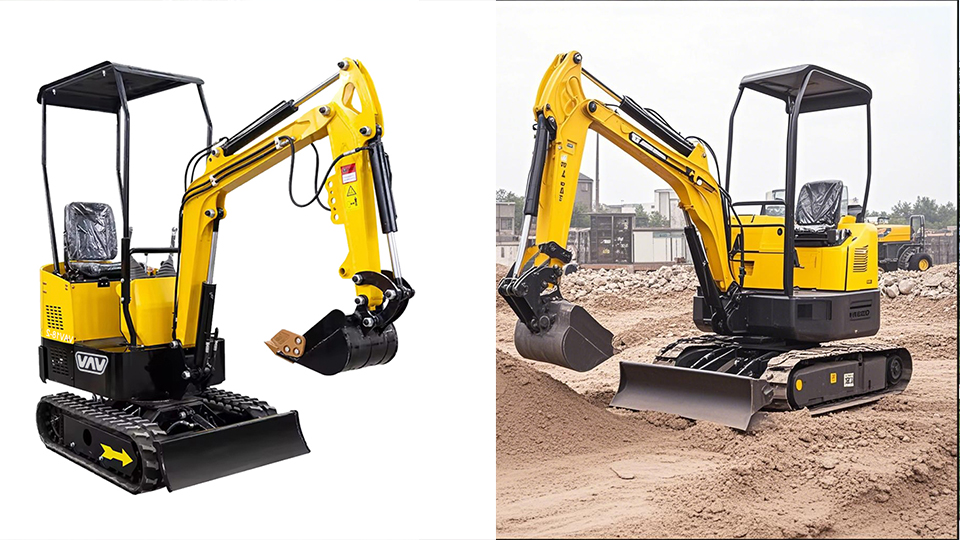The rhythmic churn of earth, the powerful swing of a boom, the precise scoop of a bucket – the excavator is an iconic symbol of construction and excavation. These versatile machines, ranging from compact models for urban landscaping to colossal behemoths for mining operations, are indispensable for a wide array of tasks. But beneath the seemingly monolithic exterior lies a complex interplay of interconnected components, each playing a crucial role in the excavator's impressive capabilities. Understanding these main parts is fundamental not only for operators and maintenance personnel but also for anyone involved in the planning and execution of projects that rely on these powerful workhorses.
This article will delve deep into the anatomy of a standard hydraulic excavator, dissecting its primary systems and components to illuminate their function and significance. We will explore the power source, the intricate hydraulic system that brings the machine to life, the robust structural elements that provide stability and reach, the diverse work tools that tackle various tasks, and the operator's station from which all this power is controlled.
1. The Powerhouse: Engine and Powertrain
At the heart of every excavator lies its engine, the source of all the mechanical and hydraulic power that drives its operations. Typically, excavators are equipped with robust diesel engines, chosen for their high torque output, fuel efficiency, and reliability in demanding environments. These engines are designed to withstand significant loads and prolonged periods of operation.
Engine: The diesel engine converts chemical energy from fuel into mechanical energy through a series of controlled combustions within its cylinders. Key specifications like horsepower and torque dictate the overall power available for hydraulic pumps and travel motors. Modern excavator engines often incorporate advanced technologies such as turbocharging, electronic fuel injection, and exhaust after-treatment systems to meet stringent emission standards and optimize performance.
Engine Cooling System: Maintaining optimal engine temperature is critical for preventing overheating and ensuring longevity. The cooling system typically comprises a radiator, coolant fluid, a water pump, and a thermostat. Airflow, often generated by a fan driven by the engine, dissipates heat from the radiator.
Fuel System: The fuel system stores, filters, and delivers fuel to the engine. It includes a fuel tank, fuel lines, fuel filters (primary and secondary), and a fuel injection pump or common rail system. Proper maintenance of the fuel system, particularly regular filter replacement, is essential for preventing engine damage and ensuring efficient combustion.
Air Intake System: The engine requires a clean and consistent supply of air for combustion. The air intake system includes an air filter to remove dust and debris, an intake manifold to distribute air to the cylinders, and sometimes a turbocharger or supercharger to increase air density and power output.
Exhaust System: The exhaust system safely expels combustion gases away from the engine and the operator. It typically includes an exhaust manifold, a muffler to reduce noise, and often catalytic converters and particulate filters in modern engines to minimize emissions.
The mechanical power generated by the engine is then transmitted to the hydraulic system, the lifeblood of the excavator's movements.

2. The Lifeblood: Hydraulic System
The hydraulic system is what gives the excavator its characteristic power and versatility. It utilizes pressurized hydraulic fluid to transmit force and motion to various actuators, enabling digging, lifting, swinging, and traveling. This intricate system comprises several key components:
Hydraulic Pumps: The heart of the hydraulic system, the pumps convert the mechanical energy from the engine into hydraulic power. Excavators typically employ multiple hydraulic pumps, such as axial piston pumps or gear pumps, to provide the necessary flow and pressure for different functions. Variable displacement pumps are common in modern excavators, allowing the system to adjust flow rate based on demand, improving efficiency and reducing fuel consumption.
Hydraulic Valves: These control the direction, flow rate, and pressure of the hydraulic fluid, directing it to the appropriate actuators. A complex network of directional control valves, pressure relief valves, and flow control valves ensures precise and coordinated movements of the boom, arm, bucket, and swing mechanism. Pilot-operated valves, controlled by the operator's levers and pedals, are often used for smoother and more responsive control of larger excavators.
Hydraulic Cylinders: These linear actuators convert hydraulic pressure into linear motion. Excavators utilize several hydraulic cylinders to power the main movements:
Boom Cylinder(s): Responsible for raising and lowering the main boom. Larger excavators may have two boom cylinders for increased lifting capacity and stability.
Arm (or Stick) Cylinder: Controls the extension and retraction of the arm, which connects the boom to the bucket.
Bucket Cylinder: Operates the tilting and digging action of the bucket.
Stabilizer (Outrigger) Cylinders (for wheeled excavators): Extendable legs that provide stability during digging operations.
Hydraulic Motors: These rotary actuators convert hydraulic pressure into rotational motion. Excavators primarily use hydraulic motors for:
Swing Motor: Rotates the upper structure (house) of the excavator relative to the undercarriage, allowing for 360-degree operation.
Travel Motors: Drive the tracks or wheels, enabling the excavator to move around the job site. Each track or set of wheels typically has its own hydraulic motor.
Hydraulic Fluid and Reservoir: Hydraulic fluid is the medium through which power is transmitted. It must possess specific properties like viscosity, lubricity, and thermal stability. The hydraulic reservoir stores the hydraulic fluid, allows for air separation, and helps dissipate heat.
Hydraulic Hoses and Lines: These flexible and rigid conduits carry the pressurized hydraulic fluid between the various components. They are designed to withstand high pressures and harsh operating conditions. Regular inspection and replacement of worn or damaged hoses are crucial for preventing leaks and ensuring safe operation.
Hydraulic Filters: These remove contaminants from the hydraulic fluid, preventing damage to sensitive components like pumps and valves. Maintaining clean hydraulic fluid through regular filter changes is essential for the longevity and performance of the hydraulic system.
Hydraulic Cooler: The continuous flow of hydraulic fluid generates heat. A hydraulic oil cooler, often air-cooled or liquid-cooled, helps to dissipate this heat and maintain the optimal operating temperature of the hydraulic fluid.
3. The Backbone: Structural Components
The structural components of an excavator provide the necessary strength, stability, and reach for its demanding tasks. These elements are engineered to withstand significant stresses and loads.
Undercarriage: The undercarriage is the lower part of the excavator that provides mobility and stability. For tracked excavators, it consists of:
Tracks (Crawler Tracks): Interlocking metal or rubber segments that provide excellent traction and stability on uneven terrain. They are driven by sprockets connected to the travel motors.
Track Frame: The main structural component of the undercarriage that supports the tracks, rollers, and idler wheels.
Rollers (Track Rollers and Carrier Rollers): Support the weight of the upper structure and allow the tracks to move smoothly.
Idler Wheel: Located at the front of the track frame, it tensions the tracks.
Sprocket: A toothed wheel that engages with the track links to propel the excavator.
Travel Motors and Final Drives: Hydraulic motors connected to reduction gearboxes (final drives) that transmit power to the sprockets. Wheeled excavators utilize tires and axles instead of tracks, offering greater mobility on paved surfaces but potentially less stability on rough terrain. They also feature stabilizers (outriggers) to provide a stable platform during digging operations.
Upper Structure (House): The rotating platform mounted on top of the undercarriage. It houses the engine, hydraulic pumps, operator's cab, boom, arm, and bucket.
Turntable (Slew Ring): A large bearing that connects the upper structure to the undercarriage, allowing for 360-degree rotation. It incorporates internal or external gearing that is driven by the swing motor.
Counterweight: A heavy weight located at the rear of the upper structure that balances the weight of the boom, arm, bucket, and lifted material, ensuring stability during digging and lifting operations.

Boom: A long, hinged arm that is attached to the upper structure. It provides the primary reach and lifting height of the excavator. Booms can vary in length and configuration depending on the excavator's intended use.
Arm (Stick or Dipperstick): A shorter, hinged arm connected to the end of the boom. It provides the digging reach and control of the bucket. Different arm lengths can be fitted to an excavator to optimize for reach or digging force.
Bucket Linkage: A system of connecting rods and levers that connects the arm to the bucket, allowing for the bucket's tilting and digging motion.
4. The Business End: Work Tools
The versatility of an excavator is largely attributed to the variety of work tools that can be attached to the end of the arm. The most common is the bucket, but excavators can be equipped with numerous other attachments to perform specialized tasks.
Buckets: Designed for digging and material handling, buckets come in various shapes and sizes depending on the material being excavated (e.g., general-purpose, heavy-duty rock, trenching, grading). They feature teeth or a cutting edge to penetrate the ground and scoop material.
Hydraulic Breakers (Hammers): Powerful percussive tools used for demolition and breaking up rock, concrete, and asphalt.
Grapples: Used for handling irregular-shaped objects such as logs, scrap metal, and debris. Different types of grapples are available for specific materials.
Shears: Designed for cutting metal, such as scrap steel and rebar, in demolition and recycling applications.
Augers: Used for drilling holes in the ground for foundations, fence posts, and other applications.
Compactors: Plate compactors or vibratory rollers attached to the excavator arm for soil and asphalt compaction.
Rippers: Heavy-duty teeth used to loosen hard or frozen ground before excavation.
Quick Couplers: Mechanical or hydraulic devices that allow for the rapid exchange of different work tools, significantly increasing the excavator's versatility on the job site.
5. The Command Center: Operator's Cab
The operator's cab is the enclosed compartment from which the operator controls all the functions of the excavator. Modern cabs are designed with operator comfort, safety, and productivity in mind.
Operator's Seat: An adjustable and often air-suspended seat designed to provide comfort and reduce operator fatigue during long working hours.
Control Levers (Joysticks): Used to control the movement of the boom, arm, bucket, and swing mechanism. Modern excavators often feature pilot-operated hydraulic controls for smooth and precise operation.
Foot Pedals: Typically used to control travel direction and speed for tracked excavators, or to operate auxiliary hydraulic functions.
Instrument Panel and Display: Provides the operator with vital information about the machine's status, including engine speed, hydraulic pressure, fuel level, and warning indicators. Modern displays often incorporate diagnostic capabilities and allow for customization of machine settings.
Safety Features: Excavator cabs are equipped with various safety features, including rollover protective structures (ROPS), falling object protective structures (FOPS), seat belts, safety glass, and often rearview cameras and proximity sensors.
Climate Control: Heating and air conditioning systems ensure a comfortable working environment for the operator in various weather conditions.
Conclusion:
The excavator, with its impressive power and versatility, is a testament to sophisticated engineering. Its main parts – the robust engine, the intricate hydraulic system, the strong structural framework, the adaptable work tools, and the ergonomic operator's cab – all work in concert to perform a wide range of earthmoving and construction tasks. Understanding the function and interrelation of these components is crucial for effective operation, proper maintenance, and ultimately, maximizing the productivity and lifespan of this essential piece of heavy machinery. As technology continues to advance, we can expect further refinements and innovations in excavator design, leading to even more efficient, powerful, and versatile machines in the future.
Post time:Sep-25-2020
